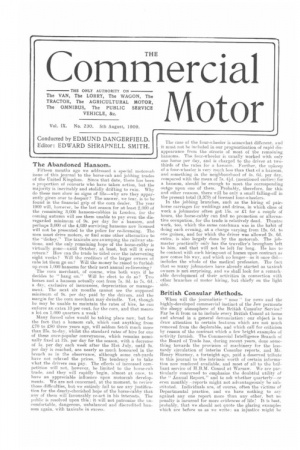The Abandoned Hansom.
Page 1

If you've noticed an error in this article please click here to report it so we can fix it.
Fifteen months ago we addressed a special motorcab issue of this journal to the horse-cab and jobbing trades of the United Kingdom. Since that date, there has been a proportion of converts who have taken action, but the majority is inevitably and stolidly drifting to ruin. Why do these men show no signs of life—why are they apparently given over to despair? The answer, we fear, is to be found in the financial grip of the corn dealer. The year 1909 will, however, be the last season for at least 2,000 of the remaining 3,000 hansom-cabbies in London, for the coming autumn will see them unable to pay even the disregarded minimum of 9s. per day for a hansom, and perhaps 3,000 of the 4,039 surviving hansoms now licensed will not be presented to the police for re-licensing. The men must drive motors, or find some other alternative to the "dickey." The taxicabs are swamping the railway stations, and the only remaining hope of the horse-cabby is virtually gone—until October, at least, but will it ever return? How can the trade be tided over the intervening eight weeks? Will the creditors of the larger owners of cabs let them go on ? Will the money be raised to furbish up even 1,000 hansoms for their next annual re-licensing F
The corn merchant, of course, wins both ways if he decides to " hang on." Will he elect to do so? Two horses and a hansom actually cost from 7s. 3d. to 7s. ed. a day, exclusive of insurances, depreciation or management. The next six months cannot see the supposed minimum of 9s. per day paid by the drivers, and the margin for the corn merchant may dwindle. Yet, though he may be unable to maintain the rates of hire, he can enforce an extra -10 per cent, for the corn, and that means a lot on 1,000 quarters a week!
Many forced sales would be taking place now, but for the fact that a hansom cab, which cost anything from £70 to £80 three years ago, will seldom fetch much more than 25s. to-day, whilst the standard rates of hire for one of these once-popular conveyances, which remains nominally fixed at 12s. per day for the season, with a decrease of is, per day each week after the 31st July, until 9s. per day is reached, are nearly as much honoured in the breach as in the observance, although some cab-yards have not relaxed the prices. The tendency is to take what the drivers can pay. The effects of increased competition will not, however, be limited to the horse-cab trade, and they will rapidly begin, almost at once, to have an appreciable influence upon motorcab developments. We are not concerned, at the moment, to review those difficulties, but we entirely fail to see any justification for the dearly-cherished hope of the horse-cabby that any of them will favourably re-act in his interests. The public is resolved upon this: it will not patronize the uncomfortable, dangerous, unbalanced and discredited hansom again, with taxicabs in excess.
The case of the four-wheeler is somewhat different, and it must not be included in our prognostication of rapid disappearance from the streets of most of the remaining hansoms. The four-wheeler is usually worked with only one horse per day, and is charged to the driver at twothirds of the rates for a hansom. Further, the upkeep of a four-wheeler is very much less than that of a hansom, and something in the neighbourhood of 4s. fid. per day, compared with the mean of 7s. 4id. (mentioned earlier., for a hansom, should be enough to meet the corresponding outgo upon one of them. Probably, therefore, for this and other reasons, there will be only a small falling-off in the present total (3,379) of licensed four-wheelers.
In the jobbing branches, such as the luring of pairhorse carriages for weddings and drives, in which class of
work a. jobmaster often got 15s. or for a couple of hours, the horse-cabby can find no promotion or alternative occupation, for the trade is relatively dead. Theatre work, too, which the same coachman was in the habit of doing each evening, at a charge varying from 12s. fid. to one guinea, and for which the driver was allowed 2s. &I. extra, is also largely done by the motorcab. The jobmaster practically only has the traveller's brougham left to him, and that will not be left for long. Re has to be content with such hiring-out of horses upon contract as now comes his way, and which no longer—as it once did— includes the whole of the medical profession. The fact that 80 many jobmasters have already started as taxied) owners is not surprising, and we shall look for a remarkable development of their activities in connection with other branches of motor hiring, but chiefly on the light side.




















